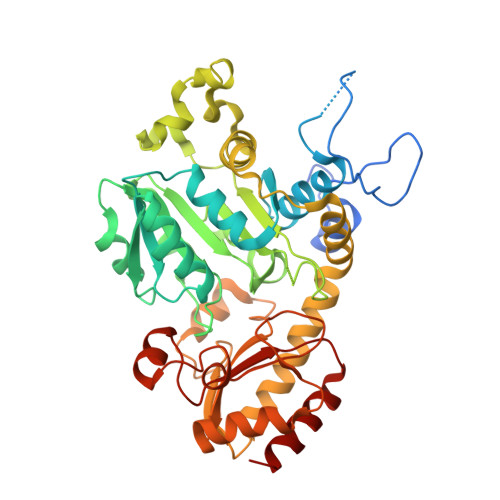pH-dependent regulation of an acidophilic O -acetylhomoserine sulfhydrylase from Lactobacillus plantarum.
Matoba, Y., Oda, K., Wataeda, M., Kanemori, H., Matsuo, K.(2024) Appl Environ Microbiol 90: e0011824-e0011824
- PubMed: 38568076
- DOI: https://doi.org/10.1128/aem.00118-24
- Primary Citation of Related Structures:
8WKO, 8WKR - PubMed Abstract:
Bacteria have two routes for the l-methionine biosynthesis. In one route called the direct sulfuration pathway, acetylated l-homoserine is directly converted into l-homocysteine. The reaction using H 2 S as the second substrate is catalyzed by a pyridoxal 5'-phosphate-dependent enzyme, O -acetylhomoserine sulfhydrylase (OAHS). In the present study, we determined the enzymatic functions and the structures of OAHS from Lactobacillus plantarum ( Lp OAHS). The Lp OAHS enzyme exhibited the highest catalytic activity under the weak acidic pH condition. In addition, crystallographic analysis revealed that the enzyme takes two distinct structures, open and closed forms. In the closed form, two acidic residues are sterically clustered. The proximity may cause the electrostatic repulsion, inhibiting the formation of the closed form under the neutral to the basic pH conditions. We concluded that the pH-dependent regulation mechanism using the two acidic residues contributes to the acidophilic feature of the enzyme. In the present study, we can elucidate the pH-dependent regulation mechanism of the acidophilic OAHS. The acidophilic feature of the enzyme is caused by the introduction of an acidic residue to the neighborhood of the key acidic residue acting as a switch for the structural interconversion. The strategy may be useful in the field of protein engineering to change the optimal pH of the enzymes. In addition, this study may be useful for the development of antibacterial drugs because the l-methionine synthesis essential for bacteria is inhibited by the OAHS inhibitors. The compounds that can inhibit the interconversion between the open and closed forms of OAHS may become antibacterial drugs.
- Faculty of Pharmacy, Yasuda Women's University, Hiroshima, Japan.
Organizational Affiliation:


















